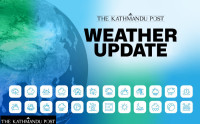Climate & Environment
Met office predicts rain for two more days
Many places in Koshi, Bagmati, Gandaki, Lumbini and Karnali provinces witnessed light to moderate rainfall on Tuesday.
Post Report
Wildfires in many forests across the country have been doused and there is no heatwave condition in most places across the Tarai region, thanks to rains on Monday and Tuesday. The rains have brought respite to Nepalis from scorching heat, haze and air pollution.
The Meteorological Forecasting Division under the Department of Hydrology and Meteorology said that most places of Koshi, Bagmati, Gandaki, Lumbini and Karnali Province witnessed light to moderate rainfall on Tuesday. Meanwhile, some places of Gandaki Province—Syangja and Baglung, among others—witnessed heavy rainfall.
“In the last 24 hours 67.8 mm rainfall has been recorded in Syangja district,” said Sanjeev Adhikari, a meteorologist at the division. “Rainfall will occur until Thursday in most provinces across the country.”
The met office's data shows Lumle Station of Pokhara recorded 63.7 mm rainfall, Janakpur 19.8 mm, Simara 18.4mm, Bhairahawa 6.9mm and Kathmandu recorded 1.1 mm rainfall on Tuesday.
Weather forecasters have urged the public to take precautions, as there are chances of strong wind, lightning along rainfall for the next three days.
The met office said that a low-pressure area formed near Bihar, India, with moisture entering the country from the Bay of Bengal, Arabian Sea and Western low-pressure system are responsible for rainfall. Rain will occur in districts of the Tarai region especially of Madhesh, Koshi and Bagmati provinces on Tuesday night.
“Maximum temperatures have declined in most parts across the country, and there are no heatwave conditions,” said Adhikari. “Forest fires have come under control in most provinces except in Sudurpaschim Province.”
The last time the country witnessed good rainfall was in the third week of March. Due to the lack of rain for a prolonged period, the country has been experiencing drought-like conditions. People across the Tarai region have been affected by the scorching heat. Severe water scarcity has been reported in many places throughout the country.
Health facilities of the Tarai region have been still grappling with an uptick in cases of diarrhoea, vomiting, and urinary infections, among other ailments.
Forests throughout the country have been either gutted by fires or are burning, deteriorating the air quality. Even flights in many places including Pokhara and Lukla, two of the country’s most popular tourist destinations, have been affected by the smoke and haze. Kathmandu has of late been among the most polluted cities in the world.
The met office had issued a special bulletin of heat wave warning twice in the third and fourth week of April.
Experts say a heat wave occurs when the maximum and minimum temperatures at a location are unusually high over two consecutive days.
Meanwhile, the maximum temperature of most districts across Tarai region went down on Sunday.
According to the Meteorological Forecasting Division, the maximum temperature of Bhairahawa has been recorded at 29.4 degrees Celsius, Janakpur 32.5, Biratnagar 30.2, Simara 33.5, Nepalgunj 35.5 and Dhangadhi 36.5 degrees Celsius. Kathmandu recorded a maximum of 24.6 degrees Celsius.
Nepal is one of the most vulnerable countries in the world to the climate crisis and has witnessed extreme weather events over the past decade and a half.
The average annual maximum temperature of Nepal has risen by 0.056 degrees Celsius, according to a study conducted by the Department of Hydrology and Meteorology in 2017. The study shows most districts witnessed increasing temperatures annually.




 18.12°C Kathmandu
18.12°C Kathmandu





